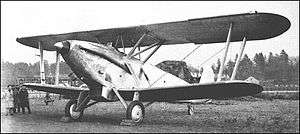Vickers Type 207
| Type 207 | |
|---|---|
 | |
| Role | Ship-based torpedo bomber |
| National origin | United Kingdom |
| Manufacturer | Vickers-Armstrongs |
| Designer | R.K Pierson & Barnes Wallis |
| First flight | 11 January 1933 |
| Number built | 1 |
|
| |
The Vickers Type 207 was a single-engined two-seat biplane designed as a shipborne torpedo bomber to an early 1930s specification. Structurally innovative, only one was built.
Development
The Vickers Type 207 was often known as the Vickers M.1/30, for it was built to Air Ministry specification for a carrier-based torpedo bomber to replace the Blackburn Ripon. The Air Ministry paid Vickers for a single prototype; its competitors were the Blackburn M.1/30 and the Handley Page H.P.46.[1]
Like Blackburn, Vickers chose the 825 hp (615 kW) Rolls Royce H10 engine, later called the Buzzard IIIMS, a liquid cooled V-12 to power their aircraft. The Type 207 was a single-bay biplane, without sweep or stagger and with wings of almost equal span. The upper wing carried Handley Page slots and Frise ailerons; the lower wing alone had dihedral. Both wings used the relatively thick and still novel Raf34 airfoil section; they folded for storage. The rudder was balanced and the braced tailplane carried aerodynamic servo-assisted elevators operated via trailing edge tabs. Barnes Wallis had recently been appointed chief structural engineer for Vickers aircraft and he brought to the Type 207 new methods of duralumin construction in both wings and fuselage from his previous work on airships. Typically, these structures were complicated but light. The aircraft was fabric-covered throughout.[1]
The upper wing was well above the fuselage, braced to it by two pairs of V-form struts on either side; two single struts from the same points on the upper fuselage braced each lower wing. The pilot sat below the wing leading edge and the observer, equipped with a Lewis gun, sat well aft. The split-axle undercarriage allowed torpedo dropping from under the aircraft and was fitted with wheel brakes as its shipborne role required, together with an arrestor hook and tailwheel. The Buzzard's underslung radiator was positioned between the forward undercarriage legs.[1]
The Type 207 flew for the first time on 11 January 1933, with Mutt Summers at the controls. The only notable modification was the addition of 2o of dihedral to the previously flat upper wing. The aircraft was lost in the first fast diving test on 23 November 1933, when structural breakup was initiated by a tailplane failure. The crew survived. In the end there were no orders for any of the M.1/30 entrants.[1]
Specifications
Data from Andrews & Morgan 1988, pp. 308
General characteristics
- Crew: two
- Length: 43 ft 7 in (13.69 m)
- Wingspan: 50 ft 0 in (15.24 m)
- Height: 14 ft 5 in (14.42 m)
- Wing area: 724 ft2 (67.3 m2)
- Empty weight: 5,200 lb (2,359 kg)
- Gross weight: 9,600 lb (4,354 kg)
- Powerplant: 1 × Rolls Royce Buzzard IIIMS V-12 watercooled engine, 825 hp (615 kW)
Performance
- Maximum speed: at 4,000 ft (1,220 m) 159 mph (256 km/h)
- Rate of climb: to 4,000 ft (1,220 m) 800 ft/min (4.1 m/s)
Armament
- 1× 0.303 in (7.7 mm) Lewis gun
- 1×torpedo of a 2000 lb (907 kg) or 1000 lb (453 kg) bomb under fuselage; or 4×500 lb (227 kg)bombs under inner wings
References
| Wikimedia Commons has media related to Vickers Type 207. |
Notes
- 1 2 3 4 Andrews & Morgan 1988, pp. 291–295, 308, 516
Bibliography
- Andrews, CF; Morgan, E.B. (1988). Vickers Aircraft since 1908 (2nd ed.). London: Putnam. ISBN 0-85177-815-1.